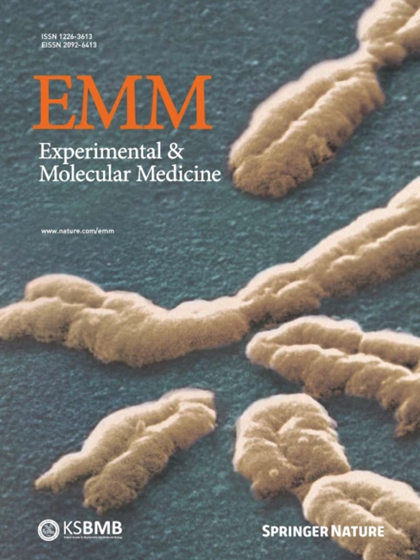Single-cell RNA sequencing and spatial transcriptomics of esophageal squamous cell carcinoma with lymph node metastases
IF 9.5
2区 医学
Q1 BIOCHEMISTRY & MOLECULAR BIOLOGY
引用次数: 0
Abstract
Esophageal squamous cell carcinoma (ESCC) patients often face a grim prognosis due to lymph node metastasis. However, a comprehensive understanding of the cellular and molecular characteristics of metastatic lymph nodes in ESCC remains elusive. In this study involving 12 metastatic ESCC patients, we employed single-cell sequencing, spatial transcriptomics (ST), and multiplex immunohistochemistry (mIHC) to explore the spatial and molecular attributes of primary tumor samples, adjacent tissues, metastatic and non-metastatic lymph nodes. The analysis of 161,333 cells revealed specific subclusters of epithelial cells that were significantly enriched in metastatic lymph nodes, suggesting pro-metastatic characteristics. Furthermore, stromal cells in the tumor microenvironment, including MMP3+IL24+ fibroblasts, APLN+ endothelial cells, and CXCL12+ pericytes, were implicated in ESCC metastasis through angiogenesis, collagen production, and inflammatory responses. Exhausted CD8+ T cells in a cycling status were notably prevalent in metastatic lymph nodes, indicating their potential role in facilitating metastasis. We identified distinct cell-cell communication networks and specific ligand-receptor pathways. Our findings were validated through a spatial transcriptome map and mIHC. This study enhances our comprehension of the cellular and molecular aspects of metastatic lymph nodes in ESCC patients, offering potential insights into novel therapeutic strategies for these individuals. Esophageal cancer is a severe disease with low survival rates, especially a type called esophageal squamous cell carcinoma. When cancer spreads to lymph nodes, it worsens the prognosis, indicating a need for better treatments. Wei Guo and colleagues studied immune cell interactions in ESCC to discover new therapies. They examined 12 ESCC patients using advanced techniques like single-cell RNA sequencing and spatial transcriptomics. These methods analyze individual cell types and their locations, helping to understand the tumor microenvironment, which is vital for cancer spread. The study identified that certain cells, such as epithelial cells and fibroblasts, play a role in metastasis. Targeting these cells might enhance treatment options. The findings emphasize that understanding TME interactions is crucial for developing new therapies, and future research could focus on these interactions to improve ESCC patient outcomes. This summary was initially drafted using artificial intelligence, then revised and fact-checked by the author.

食管鳞状细胞癌伴淋巴结转移的单细胞RNA测序和空间转录组学研究。
食管鳞状细胞癌(ESCC)患者往往因淋巴结转移而面临严峻的预后。然而,对ESCC中转移性淋巴结的细胞和分子特征的全面了解仍然难以捉摸。在这项涉及12例转移性ESCC患者的研究中,我们采用单细胞测序、空间转录组学(ST)和多重免疫组织化学(mIHC)来探索原发肿瘤样本、邻近组织、转移性和非转移性淋巴结的空间和分子属性。对161333个细胞的分析显示,在转移淋巴结中显著富集了特定的上皮细胞亚群,表明了促进转移的特征。此外,肿瘤微环境中的基质细胞,包括MMP3+IL24+成纤维细胞、APLN+内皮细胞和CXCL12+周细胞,通过血管生成、胶原生成和炎症反应参与ESCC转移。处于循环状态的耗尽CD8+ T细胞在转移性淋巴结中明显普遍存在,表明它们在促进转移中的潜在作用。我们确定了不同的细胞-细胞通信网络和特定的配体-受体途径。我们的发现通过空间转录组图和mIHC得到了验证。这项研究增强了我们对ESCC患者转移性淋巴结的细胞和分子方面的理解,为这些个体的新治疗策略提供了潜在的见解。
本文章由计算机程序翻译,如有差异,请以英文原文为准。
求助全文
约1分钟内获得全文
求助全文
来源期刊

Experimental and Molecular Medicine
医学-生化与分子生物学
CiteScore
19.50
自引率
0.80%
发文量
166
审稿时长
3 months
期刊介绍:
Experimental & Molecular Medicine (EMM) stands as Korea's pioneering biochemistry journal, established in 1964 and rejuvenated in 1996 as an Open Access, fully peer-reviewed international journal. Dedicated to advancing translational research and showcasing recent breakthroughs in the biomedical realm, EMM invites submissions encompassing genetic, molecular, and cellular studies of human physiology and diseases. Emphasizing the correlation between experimental and translational research and enhanced clinical benefits, the journal actively encourages contributions employing specific molecular tools. Welcoming studies that bridge basic discoveries with clinical relevance, alongside articles demonstrating clear in vivo significance and novelty, Experimental & Molecular Medicine proudly serves as an open-access, online-only repository of cutting-edge medical research.
 求助内容:
求助内容: 应助结果提醒方式:
应助结果提醒方式:


